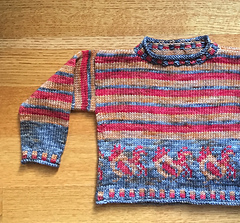patterns >  Angela Hahn's Ravelry Store
Angela Hahn's Ravelry Store
> Galletto Year of the Rooster Child's Pullover





Galletto Year of the Rooster Child's Pullover
I created this design in honor of the Chinese Year of the Rooster (and my last name, Hahn, is German for rooster, so I have a special fondness for roosters!). “Galletto” is Italian for young rooster or cockerel, and “fare il galletto” (“act like a young rooster”) colloquially means “to show off.” This pullover shows off several techniques for knitting with multiple colors: stranded colorwork, stripes (optional, see below), and corrugated ribbing.
Sizes and Garment Measurements
SIZES 21½ (24¾, 28¾, 32, 36, 39¼)
GARMENT MEASUREMENTS
Body circumference: 21½ (24¾, 28¾, 32, 36, 39¼)“/55 (63, 73, 81.5, 91.5, 99.5) cm
Upper sleeve circumference: 9½ (10¾, 11½, 12½, 13¼, 14)”/24.5 (27.5, 29.5, 31.5, 33.5, 35.5) cm
Length: 11½ (12¾,15, 17½, 20¼, 22)“/ 29.5 (32.5, 38.5, 44.5, 51.5, 56) cm
Center back neck to cuff: 12¾ (17¾, 20¼, 22, 26, 27¾)”/ 32.5 (45, 51.5, 56, 66, 70.5) cm
Shown in size 24¾. Intended ease at chest: 3-5”/ 7.5-12.5 cm in smaller 3 sizes and 4-7”/ 10-18 cm in larger 3 sizes.
Note: Size 36 should fit XS women; Size 39, S women and S men (for men, sleeves may need to be lengthened).
Difficulty
Intermediate: Skills include stranded knitting with three colors, corrugated rib, Three-needle bind-off, and picking up stitches.
Materials
Yarn #3 Light (DK) weight, 375 (525, 675, 795, 1025, 1165) yd/345 (485, 620, 730, 940, 1070) m. The above total should include a minimum of each of the following:
Color A (for stranded pattern, corrugated ribbing, and bands framing stranded pattern and finishing lower sleeves), 170 (185, 225, 245, 265, 280) yd/155 (170, 205, 225, 245, 255) m; Color B and Color C (for stranded pattern and corrugated ribbing), each, 65 (70, 80, 85, 90, 100) yd/60 (65, 75, 80, 85, 90) m.
OPTION WITHOUT STRIPES (not shown; if working body and sleeves in Color A only):
Color A, 310 (450, 590, 710, 930, 1060) yd/285 (415, 540, 660, 850, 975) m; Color B and Color C, each, same as above. Note that individual color yardages include extra to prevent running out of yarn, and do not add up to the total yardage given above.
Shown in Madelinetosh Tosh DK (100% superwash merino wool, 225 yd/205m per approx 3.5 oz/100g skein), 2* (3, 4, 4, 5, 6) skeins. The above total should include a minimum of each of the following:
Antique Moonstone (Color A), 1 (1, 1, 2, 2, 2) skeins; Pendleton Red (Color B) and Brick Dust (Color C), each 1 skein.
The stranded pattern and corrugated rib may be worked using one instead of two contrasting colors, allowing Size 21½ to be made using two skeins of Madelinetosh Tosh DK.
OPTION WITHOUT STRIPES (not shown; if working body and sleeves in Color A only):
Antique Moonstone (Color A), 2 (2, 3, 4, 5, 5) skeins; Pendleton Rd (Color B) and Brick Dust (Color C), each 1 skein.
Needles US 6/4 mm circular needle, 16-32” long depending on selected garment size, for body. US size 6/4.0 mm needles in preferred style for small circumference knitting in the round, for sleeves and neckband.
Some knitters may need to use needle one size larger to get correct gauge for stranded pattern.
Adjust needle size if necessary to obtain the correct gauge.
NOTES
Construction
The body of this pullover is worked in the round to the armholes; upper front and back are worked flat. After joining the shoulders using Three-needle bind-off, sleeve stitches are picked up around the armholes. Sleeves are worked down in the round. Body length may be easily changed since there is no waist shaping.
Stripes and using up yarn
The stripe pattern was chosen to equalize the amount of each color of yarn used, in order to avoid having most of an expensive skein of yarn (or two) left over. The stripes as shown use approximately twice as much of each of the stranded motif colors (B & C) as the stranded background color (A). The neckband is worked before the sleeves so that the remaining yarn may be divided equally for sleeves. If using up all of the yarn colors equally is not a goal, any stripe pattern may be used, or stripes may be omitted (see optional yarn requirements).
Finding correct sleeve length
I recommend taking the center back-to-wrist measurement of the wearer (with arm straight, measure from base of back neck, across shoulder, and along arm to wrist); this should approximately match the center back neck-to-cuff measurement of the finished sweater.
Checking sleeve length
The sweater can also be tried on while in progress, to check sleeve length (see Notes on checking length in progress). Arm length of children varies widely, and corrugated rib looks unsightly if cuffs are turned back, so this pattern allows for easy adjustment of sleeve length: sleeves are shaped with both paired decreases along their length, and a final decrease round in which six stitches are decreased, just before the cuff.
70887 projects
stashed
54667 times
- First published: October 2018
- Page created: October 14, 2018
- Last updated: October 16, 2018 …
- visits in the last 24 hours
- visitors right now




